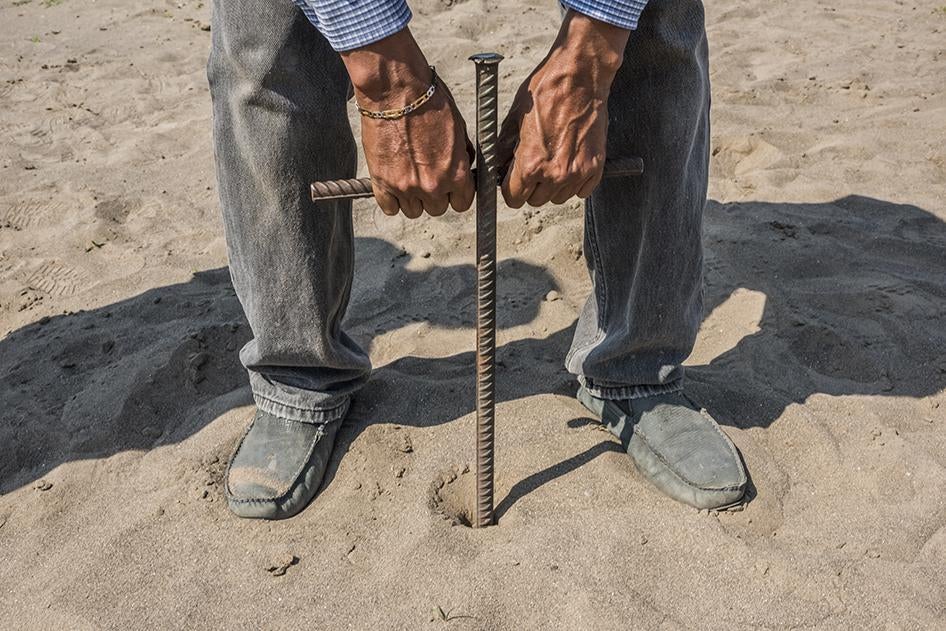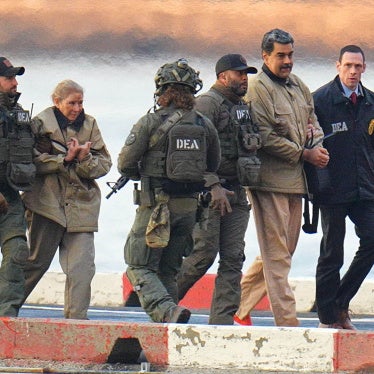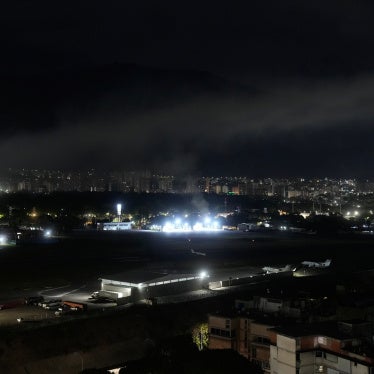***
In response to this prolonged agony, a movement has emerged in Mexico made up of people like Rocío Valencia Moreno, the parents of the 43 Ayotzinapa students, and thousands more with missing loved ones. They have banded together to form the more than 70 collectives that have been active throughout the country, scouring morgues and jails, hillsides and empty lots; knocking on government doors, marching in the streets, and talking to the media. Many now coordinate their individual and collective struggles through a national umbrella group, Movement for Our Disappeared in Mexico.
This movement is, in some respects, unlike any Mexico has seen. Its most notable feature is the peculiar quality of the suffering that drives its members to do things that few other people in Mexico would do. They press for investigations that could put them at risk of reprisals by members of organized crime or government security forces—and continue pressing even after receiving death threats that would paralyze other people. They sacrifice time, energy, savings—in some cases even homes and careers—to pursue every imaginable lead. The sort of rational cost-benefit, risk-reward analysis that leads others to tolerate the abuse, corruption and incompetence by government institutions is meaningless to them. Giving up on their missing loves is not an option.
A second distinguishing feature of this movement is its moral authority. Since President Felipe Calderón began the war on drugs in 2006, Mexican authorities have routinely encouraged the notion that the victims of violence were themselves criminals and, therefore, had gotten what they deserved. But it’s much harder to dismiss these families’ suffering as deserved. On the contrary, their plight elicits strong sympathy from most observers—and can even inspire officials to fulfill their functions with a dedication that is normally lacking.
We found this in Monterrey, Nuevo León, for example, after the local nongovernmental organization Citizens in Support of Human Rights (Ciudadanos en Apoyo a los Derechos Humanos, CADHAC), facilitated meetings between families of disappearance victims and state prosecutors beginning in 2011. Several of the prosecutors later told us that these encounters inspired in them a “moral commitment” that they had not felt before. “It makes you work harder, and not just shoot off bureaucratic dispatches like you did in the past,” one prosecutor told us. Another confessed that prior to these meetings, she would “just read the cases and file them away;” afterward she began seeking out and pursuing new leads. The result was a significant increase in the number of cases resolved and criminal charges brought against those responsible.
A third feature of the movement is its pragmatism. Unlike most other protest movements, the families of the disappeared are driven, for the most part, not by ideological or political agendas but rather by their desperation to resolve their cases. They want the government institutions to function better, no matter who happens to be in charge. One reason the collaboration between prosecutors and families in Nuevo Leon was successful, according to a staff member of CADHAC, was that the prosecutors realized the families weren’t there “to fight over power” but rather to engage in “a joint search for solutions.”
This third characteristic might seem mundane in another context. But in an era in which most politics is adversarial—and a country where many people seem to have given up on their criminal justice system (as evidenced by the fact that most crimes go unreported)—these families’ single-minded focus on getting this system to produce concrete results is nothing short of radical.
With this potent combination of qualities—implacable determination, unimpeachable moral authority, and radical pragmatism—the families of the disappeared have the potential to be transformative force in Mexico. Already their efforts have led to thousands of exhumations and judicial investigations, resulting in the resolution of hundreds of cases. And they are largely responsible for the 2017 passage of one of the most ambitious human rights laws in the country’s history.
The general law on disappearances was one of very few significant advances Mexico made in promoting human rights during the past administration. President Enrique Peña Nieto committed himself to pursuing the law in response to the national protests in support of the families of the Ayotzinapa students. Its content was shaped by the direct and active participation of victims’ families in the drafting process in Congress.
The result is a comprehensive law addressing a wide range of concerns of these families. Chief among these is finding the disappeared. The law mandates the creation of several national databases—including for missing persons and unidentified bodies—and specifies the information that federal and local authorities should collect and share. It establishes a federal agency, the National Search Commission, to coordinate search efforts by prosecutors, police and other agencies—and it requires every state to establish a similar commission. Just by ensuring that the relevant agencies share existing information through the new databases, these commissions should be able to locate a large number of the disappeared in relatively little time.
The law also contains strong provisions to promote justice. These include a definition of “enforced disappearance” consistent with international human rights law that address key features of the crime. One is the withholding of information about the victims’ whereabouts. Under the law, functionaries who do so can be prosecuted even if they didn’t participate in the detention or have any contact with the victim themselves. Moreover, the law allows for substantial sentence reductions to perpetrators who provide information regarding the fate of the victims—thus providing a powerful incentive to help reveal their whereabouts.
The law requires all states to create specialized prosecutorial units for disappearance cases—like the one that already exists in the federal prosecutor’s office. With the information generated by perpetrators seeking sentence reductions—as well as by the revamped databases and coordinated searches—these specialized units could make unprecedented progress in bringing the perpetrators to justice.
Mexico has a long history of enacting good human rights laws and then failing to implement them. But what distinguishes this one from others before it is the force of the movement of victims’ families behind it. Indeed, the law grants family members a right to participate in searches and investigations and mandates the creation of programs to protect them (and anyone else involved in the search efforts) from reprisals. It also mandates the creation of advisory councils at the federal and state level made up of victims’ families, human rights advocates, and experts to advise and monitor the work of the search commissions.
If these advisory councils—and individual families and collectives they represent—are able to work with the newly created mechanisms the way they have worked with authorities in Nuevo Leon and other parts of the country—inspiring, shaming, collaborating, or cajoling them to produce concrete results—it would be the first significant progress Mexico has made in addressing the human rights catastrophe brought on by its failed “drug war.” Success here could have an impact far beyond the disappearance cases by jumpstarting the institutions responsible for procuring justice and ending an era of near-total impunity for the security forces whose abuses have helped fuel the violence.
There are, of course, plenty of reasons to be pessimistic. One is the longstanding incapacity or unwillingness of Mexican authorities to investigate matters involving criminal activity by security forces. Another is the strong resistance by the security forces—and, especially, the military—to being held accountable in any meaningful way by civilian authorities. The odds of this dynamic of impunity continuing under López Obrador have only increased with his plan give the military a more permanent and active role in public security.
Yet hope against all odds is precisely the condition—or the curse—that has been inflicted upon the families of the disappeared who will not—indeed cannot—give up on their missing loved ones. It is a perverse paradox of Mexico’s human rights catastrophe that the suffering of these families—caused by the cruelest of its crimes—could ultimately prove to be a key to the country’s recovery.
For that to be possible, however, López Obrador will need to commit to supporting the efforts of these families, throughout the country, in the same way he has committed to supporting the families of the 43 students from Ayotzinapa. Concretely, he will need to ensure that the mechanisms established by the disappearance law are adequately funded and receiving proactive support from other government agencies—and that they are fully responsive to the citizen advisory councils, collectives and individual families. And, perhaps most critically, when the demands of the families for truth and justice meet resistance from the military and other security forces—which they inevitably will if progress is made on the many cases involving enforced disappearances—the president will need to make crystal clear which side he is on.
Daniel Wilkinson is the Americas managing director at Human Rights Watch









